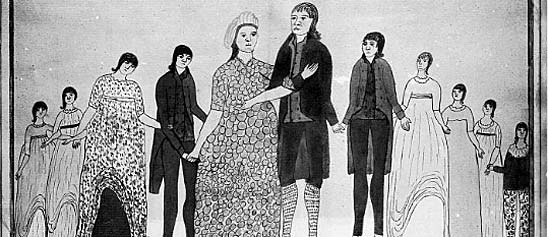In 1976, computer pioneers Steve Wozniak and Steve Jobs began selling their Apple I computer in kit form to computer stores. By August of that year, Wozniak started designing an improved version, the Apple II.
- Description
-
In 1976, computer pioneers Steve Wozniak and Steve Jobs began selling their Apple I computer in kit form to computer stores. By August of that year, Wozniak started designing an improved version, the Apple II. Wozniak and Jobs demonstrated a prototype in December, and then introduced it to the public in April 1977. The Apple II started the boom in personal computer sales in the late 1970s, and pushed Apple into the lead among personal computer makers.
-
The Apple II used a MOS 6502 chip for its central processing unit. It came with 4 KB RAM, but could be extended up to 48 KB RAM. It included a BASIC interpreter and could support graphics and a color monitor. External storage was originally on cassette tape, but later Apple introduced an external floppy disk drive. Among the Apple II's most important features were its 8 expansion slots on the motherboard. These allowed hobbyists to add additional cards made by Apple and many other vendors who quickly sprung up. The boards included floppy disk controllers, SCSI cards, video cards, and CP/M or PASCAL emulator cards.
-
In 1979 Software Arts introduced the first computer spreadsheet, Visicalc for the Apple II. This "killer application" was extremely popular and fostered extensive sales of the Apple II.
-
The Apple II went through several improvements and upgrades. By 1984, when the Macintosh appeared, over 2 million Apple II computers had been sold.
-
The Warners acquired ithis computer in the fall of 1981, partly for use by their son Benjamin who had just turned thirteen. He used it to play Pacman. Jack Warner's 2023 recollection of using the computer was as follows: "A friend told me about a wonderful new computer and a program, Visicalc, written by Dan Bricklin, that would allow you to easily manipulate numbers in cells and generate equations.
-
It proved to be a good tool to generate spreadsheets (a new word then!) to analyze potential real estate investments and returns. The kids loved to play Little Brick Out and Lemonade Stand, two games that came with the Apple software. Lisa also and Apple program allowed you to ask questions, with Lisa returning an answer that led you on. It appeared to be prescient! "Alien Rain" in which items dropped from the top of the screen and you would have to shoot them down by moving the arrow keys fascinated the kids for hours and days. The breakthrough for usefulness was the acquisition of "Magic Word", probably the first word processor for Apple. An Epson dot matrix printer was added shortly thereafter, 80 cpi, wow! The setup donated to the SI includes an Apple floppy drive and Offbrand Monitor (Apple monitors were hard to come by. At one point I unhooked the floppy drive while the machine was running and blew out the floppy board. No hot swapping then! It was all cut and try. The addition of the MicroSoft CP/M internal board later allowed the use of Wordstar, a feature rich word processor. The following year, we set up 3 Apple IIs and employed the family to quickly generate a computer file from a manuscript in record time. Impressed the client!"
-
In addition to the central processing unit and keyboard for the Apple II (1990.0167.01.1), the NMAH collections include the monitor for the machine (1990.0167.01.2), the disk drive (1990.0167.02), an Apple Silenttype printer (1990.0167.03.1) and a circuit board for the printer (1990.0167.03.2).
-
Reference:
-
Personal Communication, Jack Warner, June 30, 2023.
- Location
-
Currently not on view
- Date made
-
1977-1987
- date made
-
1980
- maker
-
Apple Computer
- ID Number
-
1990.0167.01.1
- catalog number
-
1990.0167.01.1
- accession number
-
1990.0167
